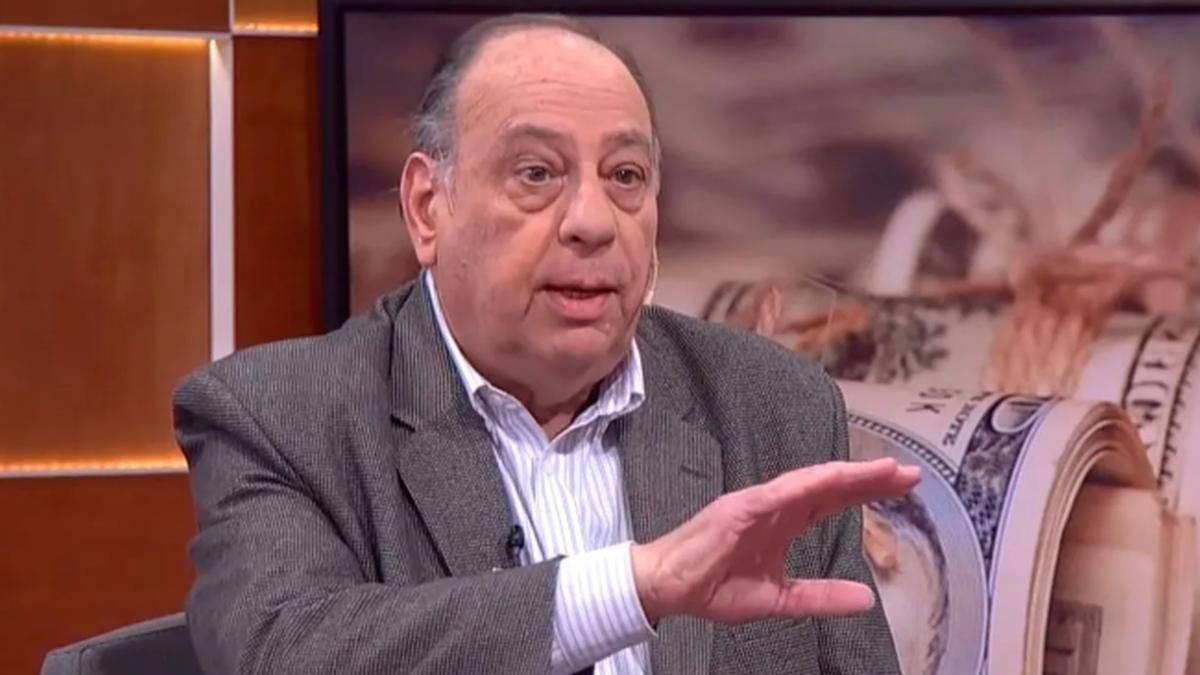Likewise, the economist ensures that the Government previously saved another episode that would have generated strong reaction in Argentine bonds and actions: the casualties of the Minister of Economy Luis Caputo and the head of the BCRA that, according to Cacanosky, They presented the resignations After Milei has unilaterally decided to reduce the withholdings to the field at the end of July, but the president did not accept them.
Next, the full interview In dialogue with Scope.
Q.: In these weeks the volatility in interest rates is discussed. You point out that you have to follow it closely because there is something that volatility means. What is showing us this movement in the rates, particularly?
Roberto Cachanosky: Well, let’s see, I think it has to do more than anything with the lack of a plan, of a clear monetary policy. If you look, the lace upload, suddenly open a more liquidity tap, they put 69%bonds. That is, there is no clear monetary policy.
For example, on August 14, Pablo Quirno, in line with the policy of restricting liquidity – because 6 billion pesos had been left – launched a tender out of agenda on a Monday to absorb that liquidity.
But if one gets into the site of the Ministry of Finance on the site, nowhere in the 22 objectives it appears that has to regulate market liquidity. That is the function of the Central Bank. So, it seems that there is a parallel central bank, in addition to the original. The first uploads the lace, then opens by giving rediscounts or loans against Lecaps that they had to buy, and on the other hand the Ministry of Finance appears by placing bonds to absorb liquidity.
Q.: Did the idea of an endogenous rate be behind?
RC: As there is nothing consistent, you have that volatility, which is the result of going to one side and the other. This idea that, at least initially, the government raised to have a change in monetary policy so that the rate is endogenous, you are not seeing it. The rate is not endogenous, neither of dollarization or anything. Here there is nothing endogenous.
In addition, when in the tender they remained with 61%, in reality the market had told them: “Of the $ 15 billion you are offering me, I want nothing more than $ 9.7 billion.” And ended up placing 9.2 or 9.3 billion. That is, it is not only a rate of rate, but of the amount of liquidity or bonds that the financial market wants to absorb. It is no longer a rate problem: banks want to have liquidity and not so many bonds.
Q.: I am interested in what it marks, because the discussion revolves around whether this volatility is something passenger or is the product of a structural problem. The Government assumed promising a dollarization. From that moment until now, where does the break between that project and these unrelated goals and laps that stand out?
RC: It is that the dollarization was, I tell you like this, a verse from Milei. He knew that it could not be dollarized. And you could not because one is in favor or against, but because there were no necessary dollars to rescue the monetary base and cancel paid liabilities.
There is a book by Emilio Ocampo, who was going to be the president of the Central Bank to close it, and my nephew Nicolás, where this issue of dollarization was discussed. They sent me the draft to think and said: “Look, everything is fine, but you want to dollarize and you will not be able to.” That is, it was known that there was no how to dollarize.
But Milei continued to sell that speech because it was campaign. People thought I was going to the cashier, having dollars and charging in dollars. He sold that illusion. It is not that there was a change of mind.
Q.: It is also true that those who could implement the plan did not accompany it in the economic team.
RC: Look that first names him, then he does not attend the phone, and puts Bausili, Caputo partner. And today they do the inverse: to say that the weight was “excrement” to sustain it as a strong currency, artificially delaying the exchange rate with interest rates, selling futures, etc. They threw themselves into the pool without having an economic plan or an economic team. So, what there was smoke. They didn’t even have a plan.
Q.: Talking with entrepreneurs, the idea appears that some measures, such as the last in monetary policy or withholdings, did not come from Caputo but from Milei directly. However, they do not seem to be liberal dye measures. Could it be Milei himself who takes measures contrary to what he proclaimed?
RC: First, they are not liberal measures. A liberal wants the exchange rate to float freely. And here does not float freely: they say yes between bands, but they really sell futures, they handle the exchange rate indirectly moving the interest rate or put the carrot of the rate to assemble the carry trade.
The decision of the withholdings, according to what I know, was from Milei. There was even a short circuit: at the time Caputo and Bausili presented the resignation. Then they continued, but the zafarrancho became bigger.
In exchange policy, Milei said: “I’m going to dollarize.” Then he put an exchange rate with a devaluation and a 2% monthly crawling, then 1% and then bands. And in the monetary, he promised zero broadcast. But since it arrived, the monetary base multiplied by four. They are data from the Central Bank.
In addition, he announced zero broadcast in July 2024, but between July 15 and early August the monetary base grew 102%. It is a story, like Kirchnerism: they say one thing and do another.
Q.: Do you think there may be a change in exchange policy after October?
RC: I would not rule out that after the elections they are sent to move. Today they are entangled in monetary and exchange policy, with triggered rates. Banks pay 50% for fixed deadlines. That is incompatible with economic activity. No lawful activity can sustain 50% real rate.
The activity has been stagnant since December. The EMAE shows two months of unstacted fall. I guess in July and August, with these rates, the fall was worse.
Q.: Is there such a thing as the “Kuka Risk” raised by the Government, in the face of the elections?
RC: That is a story. At stake for freedom there are only two deputies and one senator. The only risk would be for Kirchnerism to win in September or October. But today volatility comes more than economic impericia than politics.
Q.: During the week a corruption case appeared at the National Disability Agency. According to its director, Diego Spagnuolo, the plot involves Karina Milei as main responsible. Does the market react in the same way if corruption comes from a Peronist government than from one more aligned with markets?
RC: No, it doesn’t take it the same. This hits Karina and Milei very close, the bullets bite them next. If cell phones open, as requested, there may be enough tension in the market.
In addition, people are already economically overwhelmed. Di Tella’s consumer confidence index fell strong, especially in capital (25%) and GBA (13 or 14%). If corruption cases are added to that, you can lose the elections or make a worse choice of the expected. And other political forces that take votes may appear.
Q.: What alternatives do you see in front of a Peronist government and another of freedom progresses?
RC: I am a classic liberal. I believe in a state that exists, in institutions, in a republican liberalism. Milei is anarcocapitalista in the speech, but in the facts it takes interventionist measures. He shouts that he is the best government in history with 700 country risk points.
We propose another option: market economy but respecting institutions, congress and opposition. Neither Kirchnerism nor mileism, which are two autocratic projects.
Q.: Speaking of Congress, fiscal surplus and approved projects: Are they compatible?
RC: If possible. For example, without altering the fiscal order or eliminating items, you could – at least temporarily – increase the $ 70,000 bonus that has been frozen since March 2024. It is a specific help for retirees. In the case of the claw, we are talking about “coins”. Look: the interest accrued by LECAPS and Boncaps in July, according to data from the Central Bank, were US $ 14,500 million in a month. How are you not going to be able to lower the interest rate, “lose” bonds and, if necessary, pay somehow – emitting – to attend to those urgencies? With a little of that you can raise the bonus to $ 150,000, to tell you, and sustain it. The fiscal order can be maintained, but not in the way they are doing it, for example, consuming the routes. I travel a lot through talks in the rural sector and are destroyed, with phenomenal wells. Lowering public spending consuming the capital stock makes no sense.
In addition, I believe in Laffer’s curve: if you lower retentions to the agricultural sector, it will produce more and you will collect for other taxes -Gananances, for example. I prefer to take transitory debt while recovering activity, to improve the profile with less taxes and more production, rather than to bind me only to keep the exchange rate below.
Q.: About his candidacy: What do image surveys say?
RC: I did a survey a few months ago in CABA: it gave me 7.5% safe, and with the “very possibly” it reached 15%.
Now I go in the province of Buenos Aires. It is much bigger, as Milei started. There are no measurements with all candidates. At first I wondered why I got into this, but with the scandal and the capable economic mess I ended up making a decent paper. And in the worst case I return to mine, with my prestige intact.
Source: Ambito




